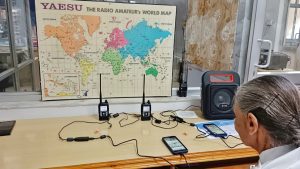


When the safety of any device is concerned, two words come to one’s mind: earthing and grounding. What are they? What is their importance? Are they the same? What is their significance from a ham’s point of view?
Grounding/Earthing: From a purely electrical point of view, earthing can be said to be a type of grounding. Grounding is referred to as the common return path of two or more devices, not necessarily connected to earth. This will restrict leakage current flow through devices. In case the devices to be grounded are far from each other and not able to get connected to obtain a common ground, then both grounds can be connected to earth, considering the whole earth as a uniform equipotential electrode; this is called earthing.
Methods: Let’s look at the topic in relation to ham radio technology. For ham stations there are mainly three types of grounding. The first is electrical safety grounding, second is RF (radio frequency) signal grounding, and the third is lightning surge grounding.
Wind flowing across the station antenna can create an electric charge, and the wind takes away some of the charge, and as a result, the wire becomes positively charged. To complete the circuit, charges need a path that must be a ground path. So in ham stations, grounds with necessary safety resistance are provided.
If proper grounding is not provided to the system, then the ham may experience undesired and problematic functioning and results. The station microphone and metallic parts may give RF shock, distortion and noise may appear in the audio signal communication, high harmonics in the transmission line may get produced, and by its production it may affect the power supply and the system. These may also lead to unwanted switching and misbehaviour in computer screens and many other problems may occur. If at the station there is a possibility of a surge attack and proper surge absorbing and grounding devices are not provided, it may damage the radio’s front terminal. So it is very important to provide grounding to any ham station for protection and effective functioning of the devices.
Electrical Safety Grounding defends you from an electrical shock hazard if one of the mains or high voltage power supply line touches the chassis due to some kind of fault. The requirement for this grounding is spelled out in the National Electrical Code. Most of the world standards associations have adopted the National Electrical Code for electrical installations, including India’s Bureau of Indian Standards. The safety ground conductor in plug sockets should be connected to ground according to this code, and the radio’s chassis should also be connected to the safety ground.
RF grounding is required only for certain types of antennas, such as ones that require current flow to the ground to complete the antenna circuit. An example is a quarter-wave vertical. One wire of the feedline connects to the antenna base, and the other connects to the ground. The connection to ground should have low RF resistance, as otherwise the power to be grounded will face heating loss. If the length of an antenna is less than one-fourth of the fundamental wavelength, then for greater efficiency a number of radial wires will be required. Basically, the relation between antenna length and efficiency is in inverse proportion. A half wavelength base-fed vertical needs only a very modest ground (i.e. ground rod). The requirements for various other end-fed antennas depend on their length. In the case of antennas such as a dipole or a ground plane, RF grounding is not required.
Lightning Surge Grounding is much more important than the other two because the surge attack is capable of producing very hazardous results. This grounding is very much essential in areas located at high altitudes from the sea level, where there is a huge possibility of a lightning strike. But it is not that essential in areas where the possibility of a surge attack is negligible. A surge attack can easily burn out and damage the equipment of a ham station. So, to overcome the problem, surge absorbers or lightning arrestors are to be employed to save the station antenna and the station itself.
Hence, in Ham Station Grounding, all three types have their own importance and accordingly, they are implemented for the system’s and the ham shack operator’s safety.